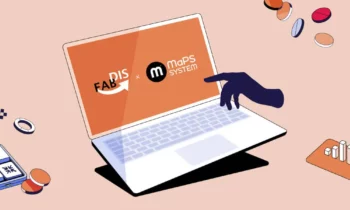What is Digital Asset Management?

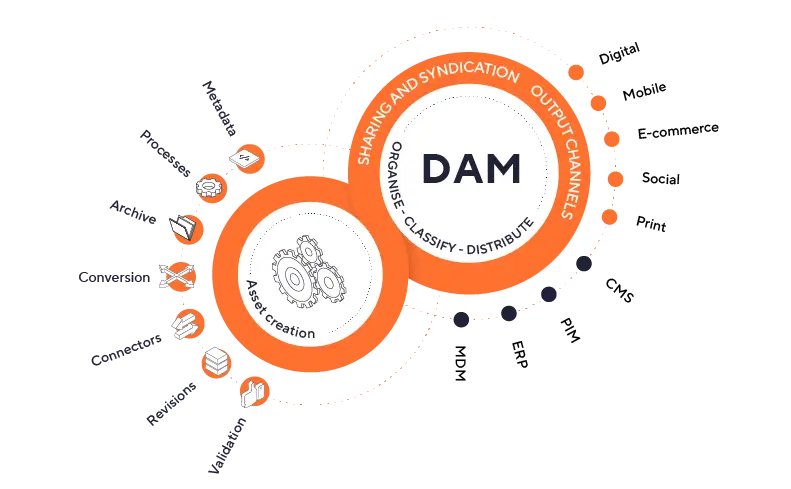
Today, corporate communication relies heavily on visual content and digital media. In this context, new challenges are emerging, especially for networked companies that need to manage thousands of images, videos, and resources.
With Digital Asset Management, you gain full control of your marketing data from end to end, acting like an invisible glue that connects all your systems seamlessly.
Definition of Digital Asset Management
The term Digital Asset Management (DAM) refers to software solutions that enable companies to store, organize, and share their digital resources in a centralized way.
Initially designed as simple storage software for a company’s multimedia content, Digital Asset Management has evolved into a true collaborative platform for managing digital content.
DAM is particularly useful for quickly and securely sharing digital assets within a company, such as images, videos, and audio files. It allows marketing, sales, and creative teams to access the company’s digital content easily and in a controlled manner.
DAM solutions handle the adaptation of media for different channels. Each asset is stored just once in high definition on the platform, then automatically adjusted according to the specific needs and the channel where it will be used.
Discover an example of a Digital Asset Management solution for large enterprises here.
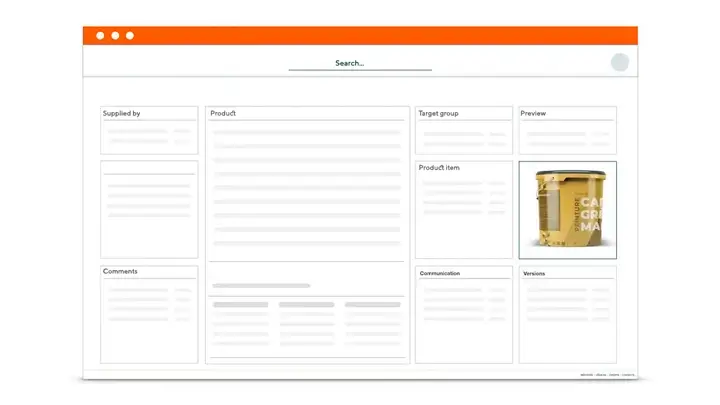
Why choose a Digital Asset Management solution?
With the abundance of digital content, companies are often faced with managing a significant number of files, which are frequently scattered across multiple servers. Digital Asset Management primarily addresses the common challenges businesses face when dealing with digital resources:
- Difficulty in sharing large files
- Wasted time searching through numerous servers and folders
- Loss and duplication of resources
- Difficulty in maintaining a consistent brand image
All companies share a common challenge: delivering the right information, through the right channel, at the right time. Given the vast volume of data to process and the increasing number of distribution channels, having the right tool to manage this information is a major asset for your business.
Implementing a Digital Asset Management solution enables you to centralize all media in one place, allowing your teams to access them quickly without wasting time searching.
In summary, a DAM solution allows you to leverage your digital assets efficiently and ensures the consistency and relevance of your projects.
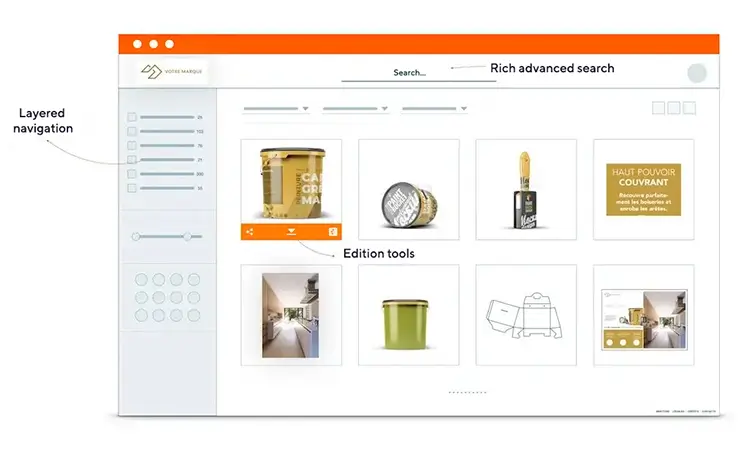
What are the benefits of a Digital Asset Management solution?
If you are responsible for managing your network’s communication campaigns, you know that handling digital assets can be time-consuming. Searching for, editing, and sharing files can take up a significant portion of your day. Digital Asset Management solutions offer numerous advantages.
- Centralize content and prevent file loss
Digital Asset Management enables companies to centralize their marketing information on a single platform. This solution provides enhanced security and reduces file duplication and loss. With a DAM solution, different departments can categorize and organize content based on predefined criteria such as keywords, format, or type. Additionally, a DAM solution allows you to track media usage and maintain full control over how assets are utilized.
- Reduce time-to-market
Enterprise DAM systems give marketers easy access to various digital assets. Acting as a media library, they store all approved digital assets ready for use. With Digital Asset Management, metadata can be easily added to simplify content indexing and searching. Users can quickly find the resources they need, speeding up product sheet creation or marketing campaigns. Content creation is also accelerated through faster workflows.
- Ensure brand control and security
Some companies operate multiple brands and subsidiaries and collaborate with various partners or agencies. This can make maintaining brand consistency challenging. Marketing teams must constantly verify that digital assets are up to date. A DAM solution establishes a single data repository where all the company’s digital content is stored. As a result, all assets comply with brand guidelines and contain relevant information. This ensures that marketing teams deliver a consistent message across all channels.
- Automate document approval workflows
More and more companies are working with external providers, such as freelancers or agencies, often located in different regions. Managing project workflows can be challenging in such cases. A DAM solution allows files to be shared online and provides access to files uploaded by other collaborators, streamlining the review and approval processes.
- Improve return on investment
A DAM solution can also distribute marketing content effectively. It allows for content personalization, which leads to more engaging marketing campaigns and provides a unique experience for each user. Additionally, the DAM system collects data to evaluate and measure content performance. This enables companies to adjust their strategies based on results, thereby increasing their return on investment.
- Enhance resource distribution and sharing
Digital channels are multiplying and constantly require more content. With a DAM solution, distributing and sharing digital resources on websites or social media platforms becomes much more efficient. A DAM tool fosters collaboration by providing a user-friendly, centralized platform for your teams. It ensures quick access to the right file at the right time and converts media formats according to usage. By integrating with the company’s various systems, the DAM provides a comprehensive view of all digital assets, allowing you to publish media quickly across social networks and third-party applications.
What are the business challenges of Digital Asset Management?
Digital Asset Management addresses significant challenges that companies face. Marketing teams, in particular, deal with daily tasks that require ensuring consistent product communication while managing content distribution and delivering a quality customer experience.
- Maintaining brand image
In networked companies, the growing number of stakeholders often requires granting some autonomy in managing communications. While personalizing communication across different networks is essential, it must remain aligned with the brand image. Therefore, it should be supervised by central teams to ensure consistent communication across all regions. A DAM solution enables the storage of files in a single location and facilitates secure sharing with various business entities.
- Saving time
Digital Asset Management should be part of a broader strategy to optimize working time. Centralizing media on one platform allows users to manage their campaigns more efficiently and quickly. DAM tools help teams eliminate time-consuming tasks, freeing them up for higher-value activities.
- Customization
A Digital Asset Management solution must seamlessly integrate into a company’s daily processes. Therefore, it is essential that the DAM can be customized and connected to other tools. In other words, for the system to be effective, it must integrate with the company’s existing tools and workflows.
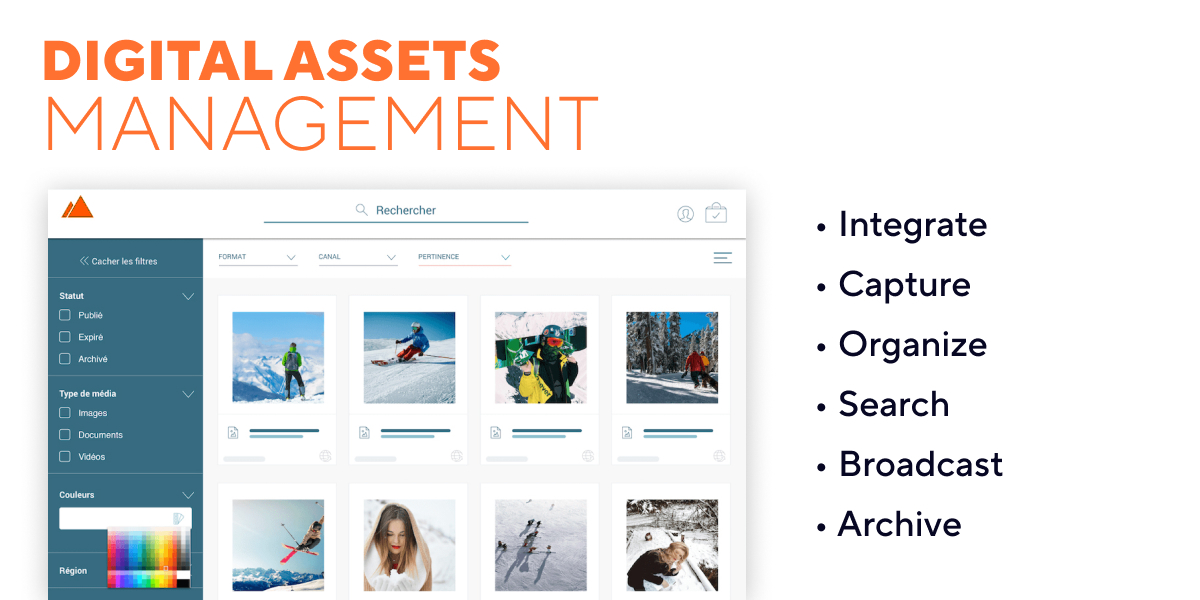
Who needs a DAM solution?
The primary role of Digital Asset Management is to simplify the management and use of marketing data. A DAM solution is particularly useful for companies that produce and use a large volume of media and marketing materials. The starting point for most DAM projects is the need to organize photos, videos, and other assets within the company. But who exactly needs a DAM solution?
A DAM solution is mainly aimed at:
- Industrial companies
- Retail businesses
- Brands
- Manufacturers
Any company that distributes and shares a significant volume of content needs a solution that allows its teams to quickly and easily take ownership of their digital assets.
- Are you part of a mid-sized or small business that produces marketing materials?
- Does your company sell products online and/or through a network of physical stores (B2B, B2B2C)?
- Do you offer a broad and diverse product range, both domestically and internationally?
- Are you facing challenges related to digital transformation and growing customer expectations?
- Are you seeking a set of communication tools to support an omnichannel experience?
- Are you looking for a fast, responsive solution that allows you to make decisions autonomously?
If so, like many companies experiencing a significant increase in digital assets, you likely need a DAM solution!
Lastly, DAM also involves managing data — the digital information collected to help understand and analyze business performance. However, it can be challenging to connect people, processes, and data within a company.
That’s exactly why DAM solutions are designed: to integrate seamlessly with a company’s software ecosystem. By centralizing data and connecting with various systems, a DAM solution provides all stakeholders with access to a single source of truth, ensuring consistency across the organization.
A project ?
Request your personalized audit
Where does DAM fit in the content value chain?
Digital Asset Management is a key link in the content value chain.
Today, DAM is structured as follows:
Production → Storage & organization → Localization & personalization → Distribution
More than just a storage base, DAM serves as a collaborative platform that centralizes and secures your data. It integrates easily with various company systems such as the CMS (Content Management System), brand portals, and provides stakeholders with a comprehensive view of multimedia resources.
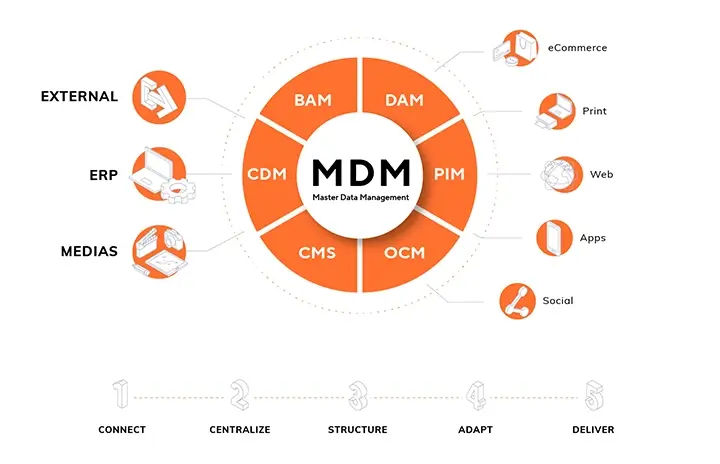
Need help framing your Digital Asset Management project? Contact our experts!


